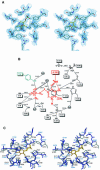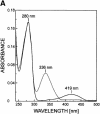Crystal structure of cystalysin from Treponema denticola: a pyridoxal 5'-phosphate-dependent protein acting as a haemolytic enzyme
- PMID: 10880431
- PMCID: PMC313955
- DOI: 10.1093/emboj/19.13.3168
Crystal structure of cystalysin from Treponema denticola: a pyridoxal 5'-phosphate-dependent protein acting as a haemolytic enzyme
Abstract
Cystalysin is a C(beta)-S(gamma) lyase from the oral pathogen Treponema denticola catabolyzing L-cysteine to produce pyruvate, ammonia and H(2)S. With its ability to induce cell lysis, cystalysin represents a new class of pyridoxal 5'-phosphate (PLP)-dependent virulence factors. The crystal structure of cystalysin was solved at 1.9 A resolution and revealed a folding and quaternary arrangement similar to aminotransferases. Based on the active site architecture, a detailed catalytic mechanism is proposed for the catabolism of S-containing amino acid substrates yielding H(2)S and cysteine persulfide. Since no homologies were observed with known haemolysins the cytotoxicity of cystalysin is attributed to this chemical reaction. Analysis of the cystalysin-L-aminoethoxyvinylglycine (AVG) complex revealed a 'dead end' ketimine PLP derivative, resulting in a total loss of enzyme activity. Cystalysin represents an essential factor of adult periodontitis, therefore the structure of the cystalysin-AVG complex may provide the chemical basis for rational drug design.
Figures








References
-
- Alexeev D., Alexeeva,M., Baxter,R.L., Campopiano,D., Webster,S.P. and Sawyer,L. (1998) The crystal structure of 8-amino-7-oxononoate synthase: a bacterial PLP-dependent Acyl-CoA-condensing enzyme. J. Mol. Biol., 284, 401–419. - PubMed
-
- Beauchamp R.O., Bus,J.S., Popp,J.A., Boreiko,C.J. and Andjelkovich,D.A. (1984) A critical review of the literature on hydrogen sulfide toxicity. Crit. Rev. Toxicol., 13, 25–97. - PubMed
-
- Brünger A.T. et al. (1998) Crystallography and NMR system: a new software suite for macromolecular structure determination. Acta Crystallogr. D, 54, 905–921. - PubMed
-
- Chu L. and Holt,S.C. (1994) Purification and characterization of a 45 kDa hemolysin from Treponema denticola ATCC 35404. Microb. Pathog., 16, 197–212. - PubMed
MeSH terms
Substances
Associated data
- Actions
- Actions
LinkOut - more resources
Full Text Sources
Molecular Biology Databases
Research Materials

